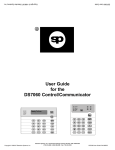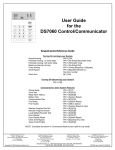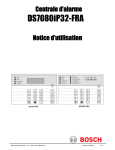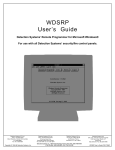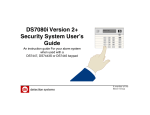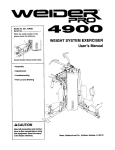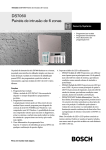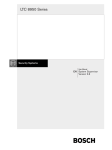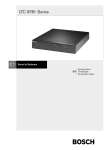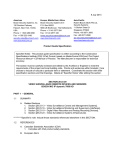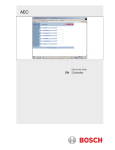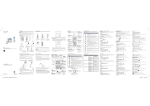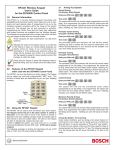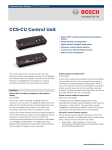Download 7060 - Acme Protective Systems
Transcript
Using Your DS7060 Control/Communicator Page 2 Contents 1.1 1.2 1.3 1.4 1.5 1.6 1.7 1.8 1.9 1.10 1.11 1.12 1.13 1.14 1.15 1.16 1.17 1.18 1.19 1.20 1.21 1.22 1.23 1.24 Understanding the DS7443, DS7445, and DS7447 Keypads ..................................................... 4 Personal Identification Numbers ............................................................................................... 6 Setting the Time ....................................................................................................................... 8 Setting the Date ....................................................................................................................... 9 Turning ON (arming) the System ............................................................................................ 10 Quick Arming the System ....................................................................................................... 12 Easy Exit ............................................................................................................................... 12 Turning OFF (disarming) the System/Silencing Alarms ........................................................... 12 Force Arming ......................................................................................................................... 14 Auto Bypass .......................................................................................................................... 15 Zone Bypass ......................................................................................................................... 15 Chime Mode .......................................................................................................................... 17 Zone Test .............................................................................................................................. 17 Local Battery/Sounder Test .................................................................................................... 19 Communicator Test ................................................................................................................ 20 Read Alarm History ................................................................................................................ 21 Fire Reset/Fire Trouble .......................................................................................................... 21 Remote Program Dial-out and Answer .................................................................................... 22 Error Displays ........................................................................................................................ 23 Duress Code ......................................................................................................................... 25 Guest Code ........................................................................................................................... 25 Emergency Procedures .......................................................................................................... 25 Emergency Keypad Alarms .................................................................................................... 26 Fire Safety ............................................................................................................................. 27 Index ................................................................................................................................. 32 This system includes a telephpne line seizure feature. The system may be programmed to communicate with a central monitoring station to report system events. You will not be able to use your phone while the system is communicating with the central monitoring station. In the unlikely event that the central station is not able to receive the report, your phone may be unavailable for up to 20 minutes while the panel makes additional communications attempts. Keypad Quick Reference Guide Turning On (arming) your System Turning Off (disarming) your System Normal Arming PIN + [On] PIN + [Off] Perimeter Arming, no entry delay PIN + [No Entry] [Perimeter Only] Perimeter Arming, with entry delay PIN + [Perimeter Only] Maximum Security Arming PIN + [No Entry] [On] Force Arming PIN + Arming Sequence + [Bypass] Zone Bypass PIN + [Bypass] followed by the Zone number Custom Arm PIN + [#] [4] Quick Arm [#] + [On] Commands for other System Features Chime Mode PIN + [#] [7] Zone Test PIN + [#] [8] [1] Read Alarm History PIN + [#] [8] [9] Battery Test PIN + [System Reset] Communicator Test PIN + [#] [8] [2] Fire Reset PIN + [System Reset] Fire Trouble PIN + [Off] to silence, PIN + [System Reset] to clear Remote Program Dial Out PIN + [#] [8] [3] Remote Program Answer PIN + [#] [8] [6] Local Battery/Sounder Test PIN + [#] [8] [5] Error Display PIN + [#] [8] [7] Error Display Reset PIN + [System Reset] Clear Zone Bypass PIN + [Bypass] [*] to clear Guest Code Enable PIN + [#] [8] [4] NOTE: Examples are shown in Commercial Mode but are valid for any mode. Page 3 Page 4 1.1 Understanding the DS7443, DS7445, and DS7447 Keypads The DS7443 is a 6 zone LED keypad; its LEDs represent the zones of the system. The DS7445 is an 8 zone LED keypad; its LEDs represent the zones of the system (LEDs for zones 7 and 8 are not used). The DS7447 is an alpha-numeric LCD keypad. All three keypads display information on various control panel functions. A built-in sounder is used to annunciate keystroke entries and as an interior warning device. Volume Control (DS7445 and DS7447 only): The keypad sounder volume can be adjusted using the [1] and [4] keys along with the [*] key. Hold the [*] key while pressing the [1] key to increase the volume or the [4] key to decrease the volume. The volume adjustment does not affect the volume during an alarm. Backlight Control (DS7447 only): The display backlight intensity can be adjusted using the [3] and [6] keys along with the [*] key. Hold the [*] key while pressing the [3] key to increase the brightness or the [6] key to decrease the brightness. NOTE: After the backlight and volume are adjusted, you must arm, then disarm the system once to store this information in the control panel. These settings will be lost in the event of total power failure to the panel. This chart will help you understand what each light/LED represents. *= This light is present on the DS7445 only. **= This light is on the DS7443 and DS7445. Page 5 Page 6 1.2 Personal Identification Numbers The Personal Identification Number (PIN) is the 4-digit code users enter at the keypad to gain access to the system. A PIN may be assigned to each User Number 001-015. The User Number identifies each person using the system. There are 15 possible User Numbers (001-015). Your system may have up to 15 different PINs, each 4 digits long. Each User Number can have only one PIN. Attempting to assign the same PIN to multiple User Numbers will result in the three-beep error tone, and the change will not be made. User Number 001 is designated as a Master Code. It can be used to add, delete, read back, or change other PINs. User Number 001 is shipped from the factory with the sequence of 1234. This code should be changed to one of your personal preference. PINs should never be programmed with common sequences such as 1111 or 2468 because they are easily violated. Adding a PIN The following chart will guide you through the steps necessary to add or change a PIN. It is recommended that this procedure be performed at a DS7447 keypad. No visual cues will be given from a DS7443 or DS7445 keypad. NOTE: Users 014 and 015 may be used for Duress and Guest Codes. See Sections 1.20 and 1.21. NOTE: You cannot read back User PIN numbers. You should keep a separate list for future reference. Removing a PIN To remove a PIN enter a [Master Code] [#] [0], the User Number of the PIN to be canceled, and then [#] again. User Number 001 can not be canceled. See Sections 1.20 and 1.21 for special uses for User Number 14 and 15 PINs. Page 7 Page 8 1.3 Setting the Time 1.4 Setting the Date Page 9 Page 10 1.5 Turning ON (arming) the System The green Status light must be on steady and no zone lights are displayed on the DS7443 or DS7445 keypad. The DS7447 display must read “Ready To Arm” in order to arm the system with one of these commands. Exception: It is still possible to “Perimeter Arm” or “Custom Arm” the system if the Perimeter or Custom arm zones are in their normal condition, even if the green Status light is off. If the green Status light is not on, or zone lights are displayed on the DS7443 or DS7445 keypad, or if the DS7447's display is reading “Not Ready,” then see Section 1.9 Force Arming or Section 1.11 Zone Bypass for other ways to arm the system. NOTE: In commercial burglar applications for U. L. Listed Requirements, a ring-back indication and bell test should be heard after arming (closing). If not heard, call for service. NOTE: If the system has invisible zones that are not ready, they will be displayed during the arming sequence. The display of invisible zones will remain on until the zone is cleared or bypassed. The chart below explains the five normal ways of arming the system. Page 11 Page 12 1.6 Quick Arming the System If Quick Arming is not used, a PIN must be entered at the beginning of all arming command sequences. When Quick Arming is used, the following shortcuts are available. Ask your installation company if you desire this feature. 1.7 Easy Exit If the system is armed and there have been no zones violated, then you can reenter a Quick Arm Command without first disarming the system. This allows you to change the arming level or to restart the exit delay so you can exit through an entry/exit zone. Easy Exit is disabled by default. Ask your installation company if you desire this feature. 1.8 Turning OFF (disarming) the System/Silencing Alarms Please read Section 1.22 Emergency Procedures prior to being confronted with an emergency event. If you have entered the building through a perimeter door, you may hear a steady pre-alert tone from the keypads. If so, disarm according to the chart below. WARNING: If the bells and sirens are on and/or the red Armed light is flashing, then the keypad is signaling that an alarm has occurred sometime before your arrival. The DS7447 will display “Zone Alarm.” The DS7443 or DS7445 zone LEDs will be flashing for the corresponding zone that is in alarm. • The keypad will also issue a pulsed tone during the entry delay instead of the usual steady tone. • If the alarm has not been previously investigated, do not enter the building unless accompanied by the appropriate Emergency Services’ personnel. This chart explains proper procedures for disarming and/or silencing alarms. Turning Off (disarming) the System under Duress A duress code is used when someone demands, by threatening your life or well-being, that the system be turned off. When used, the code will both turn off the system and report a silent duress alarm if connected to a monitoring service. User code 14 can be optionally configured as a duress code. User code 14 will not arm the system, or report duress, if the system is not armed. Extreme care should be used when entering your PIN to turn off the system, so a duress code is not inadvertently entered. User Code 14 is not a duress code by default. You must program the control panel that User Code 14 is the duress code. Ask your installation company if you desire this feature. Page 13 Page 14 1.9 Force Arming When one or more zones are faulted, the system may be Force Armed by bypassing the faulted zones. The green Status light will be off on all keypads when Force Arming is required to arm the system. The DS7447 display will read “Not Ready” or “Fire Trouble” (if a fire zone is open) and the DS7443 and DS7445 zone LEDs (1-6) will be on if one of those zones is faulted. Ask your installation company if you desire this feature. Force Arming during an AC power failure: Regular arming of the control panel is not permitted during an AC power failure. Having to Force Arm serves as a warning that the control panel is operating under backup battery. WARNING: Bypassing or Force Arming removes some of your building's protection because it excludes the faulted zones from arming. Therefore, an intrusion may not be detected or the detection may be delayed. Always attempt to correct any zone problems (close doors and windows, etc.) before using these features. If the problem can not be corrected, contact your installing company. NOTE: See Section 1.11 Zone Bypass for an alternate method of arming the system when faults exist. Force arming is not available in U. L. Listed systems. 1.10 Auto Bypass The system can be armed and will automatically bypass faulted zones. Ask your installation company if you desire this feature. 1.11 Zone Bypass There may be occasions when it is desirable or necessary to temporarily bypass one or more zones prior to arming the system. Bypass commands only work when the control panel is disarmed. For instance, an open window may cause the DS7447 display to read "Not Ready" followed by the zone number. The DS7443 or DS7445 may have one of its zone LEDs on steady. Only one zone may be bypassed each time the command is used. If more than one zone requires bypassing, repeate the command for each zone to be bypassed. NOTE: See Section 1.9 Force Arming for another method of zone bypassing. Page 15 Page 16 This chart explains the procedure for bypassing a faulted zone prior to arming the system. * If in “Residential Mode” substitute the [#] key for the PIN. NOTE: All bypasses are cleared when the system is disarmed, unless they are on 24-hour zones. To clear a bypass on a 24-hour zone, use Clear Individual or Clear All. 1.12 Chime Mode Chime Mode causes the keypad sounders to beep each time a Perimeter or Entry/Exit zone is violated while the control panel is off (disarmed). Only your installation company can determine which zones are chime zones. The [#] [7] command is used to both turn Chime Mode off and on. This chart explains the procedure for turning ON and turning OFF Chime Mode. * If in “Residential Mode” substitute the [#] key for the PIN. 1.13 Zone Test The Zone Test is used to confirm that detectors will report alarms. Zone Test works on all zones, except 24-hour zones and fire zones. While the keypad is in Zone Test, no control panel alarms will activate an alarm, except 24-hour zone alarms and fire alarms. These will override the Zone Test function. Caution: Be sure not to activate 24 hour or fire zones during the zone test or an alarm signal will be sent. The Zone Test will initiate communicator reports only if both “System in Test Report” and “System in Test Restoral Report” are programmed. Ask your installation company if you desire this feature. Page 17 Page 18 WARNING: Make sure that the report value programmed at these locations will be clearly understood at the Central Station. The “System in Test Report” will be sent, followed by the alarm and restoral reports of the zones being tested, providing their corresponding report address is programmed. After completion of the Zone Test, the “System in Test Restoral Report” will be sent. If these two reports are misunderstood, then the zone alarms might be perceived as a real violation. 1.14 Local Battery/Sounder Test This test uses the battery to manually activate all the system sounders for two seconds. If the battery voltage is low, a battery fault will occur. Page 19 Page 20 1.15 Communicator Test This test is only available if your system transmits alarms and system information to a monitoring service, and has been programmed by the security installing company to permit communicator tests. This test may only be used in the disarm mode. A long beep will initially sound to acknowledge the start of the test. If the test is successful, the sounder will again issue one long beep. If the test fails, the keypad sounder will beep three times and the Power LED will begin to flash, indicating a Control Trouble. The DS7447 keypad will display “Control Trouble Enter #87. When performing the #87 error display sequence, the DS7447 keypad will display “Control Trouble Communication Err”. The DS7443 and DS7445 keypads will turn on the Zone 3 LED. See Section 1.19 “Error Displays”. 1.16 Read Alarm History The history buffer stores the last 20 events in memory. The DS7447 can display all of these events. The DS7443/DS7445 can only display those zones (1-6) that have alarmed. **= If in Residential mode, a PIN is not required for this command. DS7447 only: Scrolling through history events. To begin scrolling through the events, press the [#] key. The [#] key will scroll you back through the history line by line. The [9] key will scroll you back in reverse order by event. Pressing the [6] key will scroll you forward through the events (towards the most recent) by event. Each event consists of two lines or display screens. The first line/screen will be the event title and user. The second line/screen will be the date of the event or the change being made. To exit the History Mode, press the [*] key or wait 20 seconds and the keypad will exit automatically. 1.17 Fire Reset/Fire Trouble Fire Reset During a fire alarm, exit the premises immediately. When you have determined there is no fire, you may silence the bells/sirens before you can initiate the [System Reset] command. PIN + [Off] will silence the sounders. This will allow a determination of which smoke detector has alarmed so the monitoring company may verify its operation. A PIN followed by the [System Reset] key will reset any smoke detectors after a fire alarm has occurred. The System Reset command will perform a fire reset, will perform a battery test, and will clear all system troubles. Page 21 Page 22 Fire Trouble A Fire Trouble display signifies a problem with the fire system, such as a break in the wiring that monitors smoke detectors. A Fire Trouble will be indicated by a short beep from the keypad sounders every 10 seconds. The DS7447 will display “Fire Trouble” followed by the zones in a trouble condition. The DS7443 will turn the Fire light on steady and will light the corresponding zone LEDs. The DS7445 will turn the Fire and Trouble lights on steady and will light the corresponding zone LEDs. Notify your installing company immediately if the Fire Trouble message is displayed. The Fire Trouble beep can be silenced with any PIN followed by the [Off] key. After problems have been remedied, a PIN followed by [System Reset] should be entered to clear the “Fire Trouble” display. 1.18 Remote Program Dial-out and Answer Note: These features should be used by qualified installation personnel only. Call for Remote Programming This command can only be entered when the control is disarmed. Phone numbers 1 and 3 must be programmed, along with account code 1. The panel will call phone number 3 and attempt to connect for downloading. While programming is underway the Status, Armed, and Power LEDs will flash. If the panel is already using the phone line, it will sound the three beep error tone. Answer for Remote Programming The panel will automatically pick up the phone line to answer a remote programming call. While programming is underway the Status, Armed, and Power LEDs will flash. If the panel is already using the phone line for a report communication, it will sound the three beep error tone. This command can only be entered when the control is disarmed. This chart will help you to call or answer the Remote Programmer. ** = Phone numbers 1 and 3 must be programmed. Phone #1 Account Code must be programmed. 1.19 Error Displays Control panel problems are indicated by a flashing green Power light. The DS7447 display will also read “Control Trouble, Enter [#] [8] [7].” The DS7443 and DS7445 will only flash the green Power light. The error messages may only be read when the control is disarmed. Contact your installing company if the problems persist. Page 23 Page 24 ** = Battery Trouble and Communicator Err displays must be cleared by the [System Reset] command sequence even after the problem has been remedied. These displays will not self clear. All the other error displays will self clear from the keypads once the problem has been remedied. 1. DS7447 - “AC Power Failure” DS7443 or DS7445 - LED 1 turns on steady There is a power failure and the panel is operating on backup battery. 2. DS7447 - “Battery Trouble” DS7443 or DS7445 - LED 2 turns on steady If the system has just been through a power failure, wait at least two hours for the battery to recharge, then enter a PIN + [System Reset] to perform a battery test. 3. DS7447 - “Communicator Err” DS7443 or DS7445 - LED 3 turns on steady The communicator failed to communicate with the central station. 4. DS7447 - “System Fault” DS7443 or DS7445 - LED 4 turns on steady Internal error in the control circuitry or optional circuitry. These system faults are: Ram Fault, ROM Fault, EEPROM Fault. 5. DS7447 - “Keypad Fault” DS7443 or DS7445 - LED 5 turns on steady One of the keypads is not responding to the control panel. 6. DS7447 - “Aux Power Fault” DS7443 or DS7445 - LED 6 turns on steady The auxiliary power has been shorted. 7. DS7447 - “Zone Trouble” DS7443 or DS7445 - LED of the zone in trouble will light One of the zones is not responding to the control panel. This may also be displayed during power-up (if so, ignore). 1.20 Duress Code User Code 14 may be used as a duress PIN number. When the system is disarmed using this duress code, a silent report is sent to the central station. Duress codes are intended to be used when a user is forced to disarm the system. Ask your installation company if you desire this feature. 1.21 Guest Code User Code 15 may be programmed to be a Guest Code. After the Guest Code has been programmed, it is enabled by depressing [PIN] + [#] [8] [4]. The Guest Code may now be used to arm and disarm the system. It remains active until the panel is disarmed with any other valid code. Ask your installation company if you desire this feature. 1.22 Emergency Procedures Identifying Alarm Sounds Your alarm system may be programmed for a steady alarm sound or a pulsed alarm sound. It is important to learn the difference between a fire alarm sound and an intrusion alarm sound before you are confronted with an actual emergency. Silencing Alarms All alarms can be silenced with any PIN. Entering your PIN + [Off] will silence the alarm and turn off (disarm) the control. A Cautionary Note How you respond to an alarm will depend, mostly, on the type and time of the alarm. You should seek the advice of your installing company as they install your system, not later (e.g. after an alarm) to develop a response plan. Above All Else, Common Sense Should Prevail If there is any threat or hint of danger to yourself or others on the premises, such as in the event of a fire alarm, everyone should be instructedto leave the premises immediately. Do not enter the premises unless accompanied by the appropriate Emergency Services’ personnel, or after they have given the OK to enter. Page 25 Page 26 Caution When Entering A Building If the bells and sirens are on and/or the red Armed light is flashing (with the DS7447 display reading “Zone Alarm” or the DS7443 or DS7445 having its zone LEDs flashing) then the keypad is signaling that an alarm has occurred. The keypad will also issue a pulsed tone during the entry delay instead of the usual steady tone. If the alarm has not been previously investigated, do not enter the building unless accompanied by the appropriate Emergency Services’ personnel. Fire Alarms Fire Alarms are silenced by using the same procedure as intrusion alarms: a PIN + the [Off] key. The Fire Alarm system is not reset until alarms at smoke detectors are cleared by using the [System Reset] command. The Fire Alarm system will not be functional until this procedure has been followed. See the “Fire Reset” section. 1.23 Emergency Keypad Alarms The Emergency Alarm Keys [A], [B], and [C] may generate Fire, Special Emergency, and Panic Alarms if programmed by the installer. Ask your installing company to explain the function of these keys. When using the Emergency Alarm Keys, they must be pressed for two seconds to generate an alarm. NOTE: If the Emergency Alarm keys are to be used, they should be labeled to signify their functions. The “A” key should be labeled as the Fire key. This is the only key that may be designated as the Fire key. The “B” key should be labeled as the Help key. The “C” key should be labeled as the Panic key. Use the Disarming Command Sequence to cancel or silence these alarms. 1.24 Fire Safety This fire alarm system can provide early warning of a developing fire. Such a system, however, does not ensure protection against property damage or loss of life resulting from a fire. Any fire alarm system may fail to warn for any number of reasons (e.g. smoke not reaching a detector that is behind a closed door). When considering detectors for residential applications, refer to NFPA Standard 72, “The National Fire Alarm Code.” This standard is available at a nominal cost from: The National Fire Protection Association, Batterymarch Park, Quincy, MA 02269. If Installed in Family Residences Adherence to the NFPA Standard 72 can lead to reasonable fire safety when the following items are practiced: • Minimize hazards: Avoid the three traditional fire killers: smoking in bed, leaving children home alone, and cleaning with flammable liquids. • Provide a fire warning system: Most fire deaths occur in the home, the majority, during sleeping hours. The minimum level of protection requires smoke detectors to be installed outside of each separate sleeping area and on each additional story of the dwelling. For added early warning protection, it is recommended that detectors be installed in all separated areas including the basement, bedrooms, dining room, utility room, furnace room, and hallways. Page 27 Page 28 Having and Practicing an Escape Plan A fire warning may be wasted unless the family has planned in advance for a rapid and safe exit from the building. • Draw a floor plan of the entire house showing two exits from each bedroom and two from the house. Since stairwells and hallways may be blocked during a fire, the plan should provide exits from bedroom windows. Make copies of the plan and practice it with all family members. • Prearrange a meeting place outside and away from the residence. Once out of the building, all occupants should immediately go to the preselected location to be accounted for. • Provide a barricade between family members and fire, smoke, and toxic gases (e.g. close all bedroom doors before retiring). • Children should be instructed on opening their bedroom windows and exiting safely from the building. If exiting is not possible, they should be taught to stay at the open window and shout for help until it arrives. • In the event of a fire alarm after retiring, wake the children by shouting to them from behind your closed door. Tell them to keep their bedroom doors closed. • If the top of your bedroom door is uncomfortably hot, do not open it. There is most likely fire, intolerable heat, or smoke on the other side. Shout to all family members to keep their bedroom doors closed and to exit the building via alternate routes. • If the top of the door is not uncomfortably hot, brace the bottom of the door with your foot, and the top with one hand, then open the door about one inch. Be prepared to slam the door shut if there is any pressure against the door or if any hot air rushes in. • If there is no evidence of excessive heat or pressure, leave the room and close the door behind you. Shout appropriate instructions to all family members and immediately leave the building via the pre-planned routes. If heavy smoke is present, drop to your hands and knees, or crawl to remain below the smoke level. Installation Considerations Proper location of detection devices is one of the most critical factors in a fire alarm system. The following are some general considerations: • Smoke detectors should not be installed in “dead air” spaces or close to ventilating or air conditioning outlets because smoke may be circulated away from the detector. Locations near air inlets should be favored. • Avoid areas subject to normal smoke concentrations such as kitchens, garages, or near fireplaces. • Do not install smoke detectors where normal area temperatures are above 100° F (38° C) or below 32° F (0° C). • Areas of high humidity and dust concentrations should be avoided. The edge of ceiling mounted detectors should be no closer than 4 inches (10 cm) from any wall. • Place the top edge of wall mounted detectors between 4 and 12 inches (10 to 30 cm) from the ceiling. For exact mounting information, refer to the instructions provided with the smoke detectors. Page 29 Page 30 Page 31 Page 32 Index M Master Code 6 A Alarm Sounds 25 Arming Force Arming 14 Quick Arming 12 Turning ON (Arming) the System 10 Auto Bypass 15 C P Panic key 27 Personal Identification Numbers 6 Adding a PIN 6 Removing a PIN 7 R Duress Code 25 Read Alarm History 21 Remote Program Dial-out and Answer 22 Remote Programming Answer for Remote Programming 22 Call for Remote Programming 22 E S Easy Exit 12 Emergency Alarm Keys 27 Emergency Keypad Alarms 26 Emergency Procedures 25 Silencing Alarms 25 Chime Mode 17 D F Fire Alarms 26 Reset 21 Safety 27 Trouble 22 For Service T Tests Communicator Test 20 Local Battery/Sounder Test 19 Z Zone Bypass 15 Test 17 Please contact your Installing Company at the above number G Guest Code 25 K Keypads Backlight Control 4 DS7443 4 DS7445 4 DS7447 4 Volume Control 4 Copyright © 1996-98 Detection Systems, Inc., 130 Perinton Parkway, Fairport, New York, USA 14450-9199 DS7060 Users Guide P/N 29955E 11/98
































